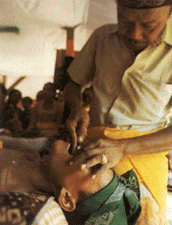|
TOOTH FILING
Every Balinese Hindu must
have a ritual ceremony called mepandes or metatah in their youth period.
The procedure of this ceremony is dulling someoneís canine teeth before
marriage, but for girls, after the first menstruation. Why is metatah is
so important for Balinese people?
 Balinese
Hinduism can be very highly symbolic, and canine teeth or caling (Balinese
word) or fangs is the symbol of bad behavior, uncivilized, even Ďevilí.
So, dulling the canine teeth wished can smooth out the bad behavior. Balinese
Hinduism can be very highly symbolic, and canine teeth or caling (Balinese
word) or fangs is the symbol of bad behavior, uncivilized, even Ďevilí.
So, dulling the canine teeth wished can smooth out the bad behavior.
The person who is expert
in filing the teeth is called sangging. According to tradition and lontars,
a sangging for tooth filing must be of the Brahmana caste. But, today,
lower caste also perform the ceremony. However, most families still prefer
to call one of the Brahmana sangging to the task.
Since tooth filing is so
important, the family who held this ceremony will invite their relatives,
neighbors and friends; musicians are hired; offerings made; a high caste
filer (sangging) will be invited to supervise the ceremony; and the finest
clothing is provided for the ceremony participants. In short, the metatah
is very expensive. Because of the cost, tooth filing is almost always an
adjunct of another ceremony, perhaps a wedding.
On the day of metatah, the
house where the ceremony held is greatly decorated, wrapped and hung with
kampuh or gold cloth that used for rituals ceremony. Offerings are everywhere,
the filees are dressed in their very finest clothing . Boys are wrapped
in a wide piece of songket, gold brocade, that reaches from armpits to
knees, with a sash of yellow tied around the waist and a kris dagger slung
across the back. Girls wear their lovely traditional kambens, their upper
body wrapped tightly with meters of cloth strips. They are crowned with
fragrant flowers and gold leaves are wound in their hair. Both boys and
girls may wear make up.
When the rituals begin, the
boys and girls lie on a woven mat. The sangging open a yellow coconut (nyuh
gading), empties it of its water, and inscribes upon it the magic symbol
(ongkara). Tools are laid out, mouthwash is made ready, and a large offering,
canang oyodan, is brought close by. The coconut acts as a spittoon nearby.
A silver bowl of holy water and a white cloth are at the ready.
Each candidate stands at
the end of the bed opposite from where the sangging will work. They hold
their hand to receive a prayer, and waft the essence of the offerings toward
themselves. The kris worn by the boy must be removed. The candidate takes
off his or her sandals, climbs onto the bed, and receives another mantra
and more holy water. He or she then lies down on the bed and is covered
with decorated cloth. Parents and close relatives crowd around to put their
hands on the boy or girl to ward off evil.
The sangging puts a small
cylinder of sugarcane in the patientís mouth, wedged between the teeth,
to keep the jaws open. The sangging may joke with the participant as he
works. He then take his small file, kikir, and with his index finger on
the flat of the file, sets to work filing. The only teeth that are modified
are the two canine teeth in the upper jaw and the four incisors between
them, six teeth (symbolizing the sad ripu (six enemies of humanís soul):
lust, greed, anger, drunk, confusion, and jealousy). Reducing the influence
of these six will help an individual live a healthy, well-adjusted existence
as
apart of a closely knit family
and community, and this behavior will insure reincarnation into a better
future life.
The procedure takes only
a few minutes, after that the boys or the girls spits the saliva containing
the filings into the yellow coconut and it must be buried near the most
important shrine in the family temple which insures that its power will
always be close to the individual.
|